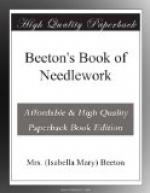Always begin with the colour which is used the oftenest; those colours that lose their dye in working must be put in last. When the pattern is finished begin the grounding. The wool must not be drawn too tightly, otherwise the threads of the canvas appear. If the wool is too coarse for the canvas, one long stitch is to be made from left to right as far as the particular colour is to be worked, and over this long stitch, cross back in the usual way.
The plainest stitch in Berlin wool work is the common cross stitch; illustrations 577 to 584 show varieties of the same.
We now proceed in the following pages to show, by description in writing and by most careful illustration, all the stitches which are used in Berlin Work. These are numerous, but neither too great in number nor too simple or too elaborate in execution for those who aspire to become Berlin workers.
* * * * *
[Illustration: 577.—Common Cross Stitch.]
ILLUSTRATION 577.—The common cross stitch is worked in rows backwards and forwards over 2 threads in height and 2 in width (square of the canvas) in straight lines; the 1st row is worked from left to right; the 2nd row, which completes the stitches, from right to left. Illustration 577 shows 2 rows of completed stitches and 1 row in course of working.
* * * * *
[Illustration: 578.—Long Cross Stitch.]
ILLUSTRATION 578 shows the long cross stitch. It is worked like the preceding one, only over 4 threads in height and 2 in width.
* * * * *
[Illustration: 579.—Long Cross Stitch.]
ILLUSTRATION 579 shows a long cross stitch, which is worked like the preceding one, except that 2 threads are missed between 2 stitches, and in the next row the stitches are worked between those in the preceding row. This stitch is not worked in rows backwards and forwards; each stitch is completed before beginning the next.
* * * * *
[Illustration: 580.—Slanting Cross Stitch.]
ILLUSTRATION 580.—The long slanting cross stitch is worked like No. 578, in rows backwards and forwards; the 1st row is slanting, the 2nd is straight. The places for inserting the needle and for drawing it out are marked on the illustration with a cross and dot.




